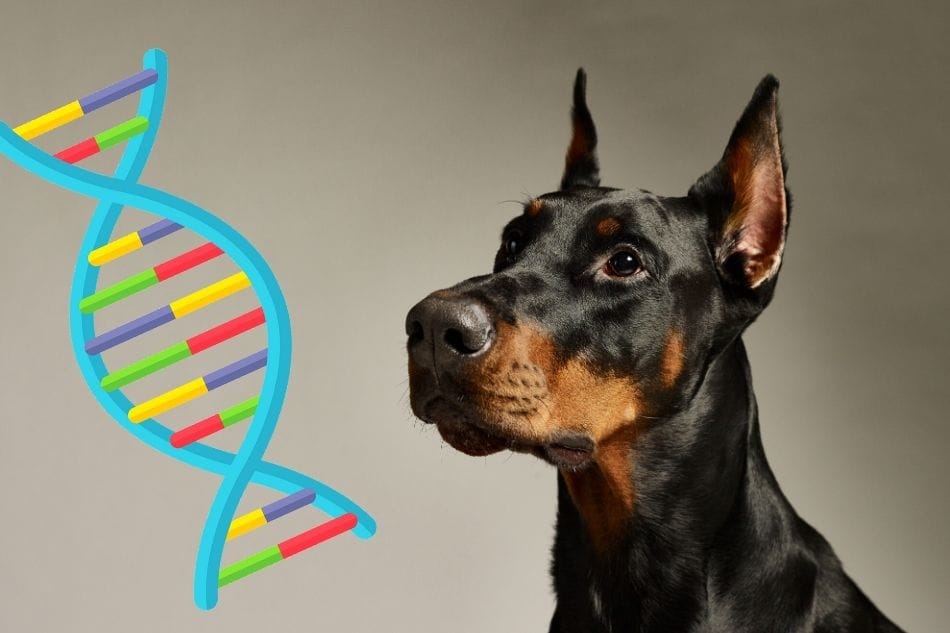
Reviewed by Dr. Sophie Liu, DVM, DDP Co-Founder
Now more than ever, it’s critical that Doberman owners DNA health test their dogs. Dilated cardiomyopathy (DCM) testing specifically has become critically important since this terrible condition can leave a pup dead within only a few years of life, and has been shown to affect up to 58% of all Dobermans.
Your Doberman could have the genetic mutations linked to this, and other, terrible disorders and you would never know it until it was too late. That is, of course, unless you do a DNA health test first. Modern canine DNA tests are really quite amazing and now they can even give you something called the genetic COI, or the coefficient of inbreeding of your dog, which has been correlated in many other species to associate with longevity.
You can get the Embark Breed and Health DNA Testing Kit here (it’s perfect for Dobermans). HINT: Right now if you use coupon code “DOBERMANPLANET” you’ll get $5 off. Not a ton, but the good news is it still works even WITH any current sales/promotions Embark has going on (most Coupon codes don’t do that), so you can get a very good deal with this as Embark is frequently running promotions.
Table of Contents
What Modern DNA Tests Can Tell You
Home DNA health test kits sure have come a long way in recent years. It seems each year they provide more insight into your dog’s makeup and background. The higher-end “all-inclusive” test kits and companies will provide you with an impressive list of insight into your dog including:
- Genetic Disorders – Inherited disorders potentially affecting your dog.
- Health Problems – Health problems your dog is prone to develop during their lifetime.
- Breed Make-Up – The various breeds used in your dog’s breed makeup going back three generations.
- Coefficient of Inbreeding (COI) – This measures the amount of inbreeding that took place in your dog’s genetic makeup and can even give insight into your dog’s lifespan.
- Color Genetics – What colors of Doberman your dog is capable of producing in their offspring.
- Albinoidism – If your dog is a “Z-factor” Doberman, meaning they carry the gene for oculocutaneous albinism (white Dobermans).
- Relatives – Some tests will even match your dog with others who have been tested that are genetically related. They’ll even allow you to send messages to the owners.
- Other Traits – Identification of various genes that will give an idea of a long list of physical characteristics of your dog including coat length, coat texture, muzzle length, tail length, muscle mass, eye color, overall adult body size, appetite levels, altitude tolerance, and more.
If you use a reputable company for health testing your Doberman, the insight that these tests can provide is simply amazing. Specifically, the various genetic disorders and related health implications are incredibly important to Doberman owners, but one very interesting result is called the genetic Coefficient of Inbreeding (or COI). This is a fascinating insight these kits can provide that is about as close as modern technology can get to a DNA test for your dog’s lifespan.

Important Health Tests for Dobermans
Every major health testing kit out there will brag about the long list of disorders they test for. But here’s what they don’t want you to know—most of those tests will have zero use to someone testing a Doberman.
This is because a DCM test for a Schnauzer, for example, is a completely different test than what’s appropriate for detecting DCM-linked gene mutations in a Doberman. So if you find a test kit that says it tests for “DCM”, that doesn’t mean it’ll necessarily be meant for Doberman DCM testing.
Make sure to forward your test results to your veterinarian so a plan can be made to address any issues that may have come to light.
My dog Arlo is a perfect example of this. His veterinarian used a genetic testing provider to check him for everything under the sun (150+ disorders, including DCM). And he came back clear of everything. A future test I did with Embark revealed he actually had two copies of the DCM1 gene mutation. Why the discrepancy? It turns out, my veterinarian’s test was looking for a DCM indicator for another breed, not for Dobermans. This was not printed on any of their material and it took a phone call to their geneticists to figure this out.
So even though I got an “all clear” for the DCM gene mutations from my vet, my dog was far from all clear. It was the wrong test.
So besides making sure the test kit you pick checks for the health concerns most appropriate for the Doberman breed specifically, you’ll also need to make sure the individual tests themselves are tests that work for Dobermans. Do you wonder why figuring out the best DNA testing kit for Dobermans took me days of research? This is why.
These are the health tests you’ll want to make sure your kit checks for in your Doberman:
- DCM1 (Dilated Cardiomyopathy) – The “DCM1” test is the correct test needed for Dobermans to detect the mutation in the PDK4 gene which has been linked to the development of DCM in Dobermans. DCM is a chronic heart disease that typically takes the life of the dog within 6 months of diagnosis. This disease is very common in the Doberman breed and believed to affect up to 58% of all Dobermans at some point in their lives.
- DCM2 (Dilated Cardiomyopathy) – The “DCM2” test looks for a mutation in the TTN gene which has also been linked to the development of DCM in Dobermans.
- DM (Degenerative Myelopathy) – This test looks for a mutation in the SOD1-A gene that has been linked to the development of DM in many breeds, including Dobermans. DM is a form of spinal cord degeneration that causes a gradual paralysis or lameness.
- vWD (Von Willebrand Disease) – The “vWD Type 1” test is the correct test for Dobermans. This looks for defects in the VWF gene which is linked to the development of vWD in Dobermans. vWD is a blood clotting disorder common in the Doberman breed.
- Doberman Vestibular Deafness (DVDob or DINGS) – This disease causes hearing and balance problems in Dobermans. It’s a progressive disease that often leads to complete deafness. This is fairly prominent in the Doberman breed and current estimates are that it affects 13% of the breed.
There are definitely other tests that are also important but these are the major ones that are critical for Dobermans. You’ll also definitely want to find a modern test kit that will give you your dog’s “coefficient of inbreeding”, or COI. This is a fascinating number that can actually give you insight into the potential longevity of your dog. But more about that in a later section.
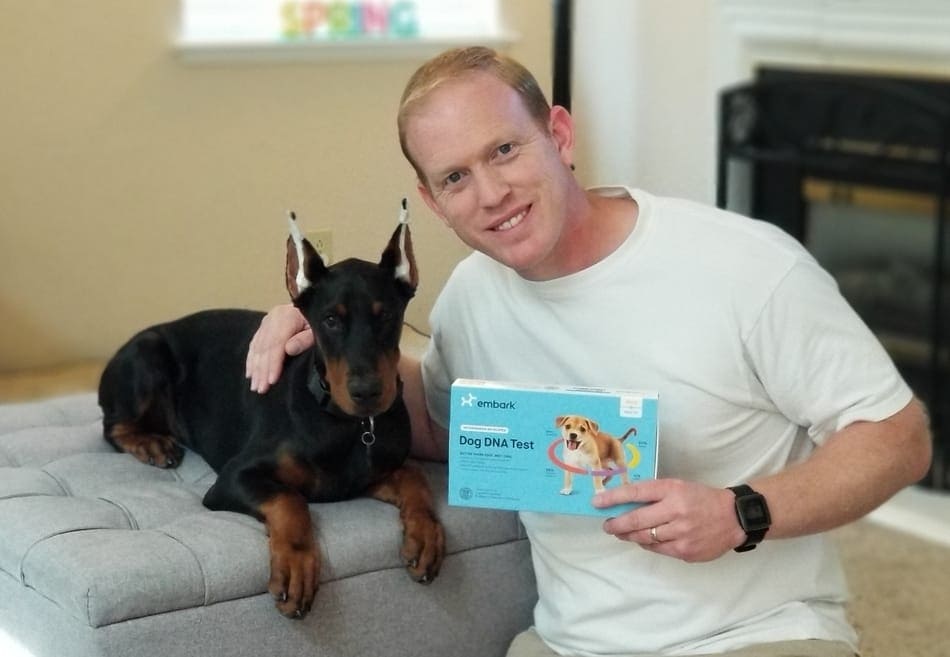
Instructional Video
I put together the video below to walk you through the step-by-step process of home DNA testing your dog. It’ll show you how to activate your kit, collect the sample, send the sample in, and how to use this guide to find out what the results mean for your Doberman.
Best DNA Health Kit for Dobermans
There are countless ways to “health test” a Doberman Pinscher so I finally decided to tackle this problem head-on. I spent two solid days of research to figure out which home DNA health testing kit was best for the Doberman breed, specifically.
This means I spoke with renowned Doberman breeders, went through the fine print on numerous DNA test kits on the market line by line, and meticulously narrowed down my list until I came up with what I believe is the absolute best approach for DNA health testing a Doberman.
This task was a bigger undertaking than I had initially anticipated though since so many dog DNA testing companies appear to offer every test you could possibly imagine, yet only a handful (if that) will be of any help whatsoever to a Doberman owner.
The final conclusion of my research was that the best health test kit out there for Dobermans was this breed ID and health test kit from Embark (green or blue box).
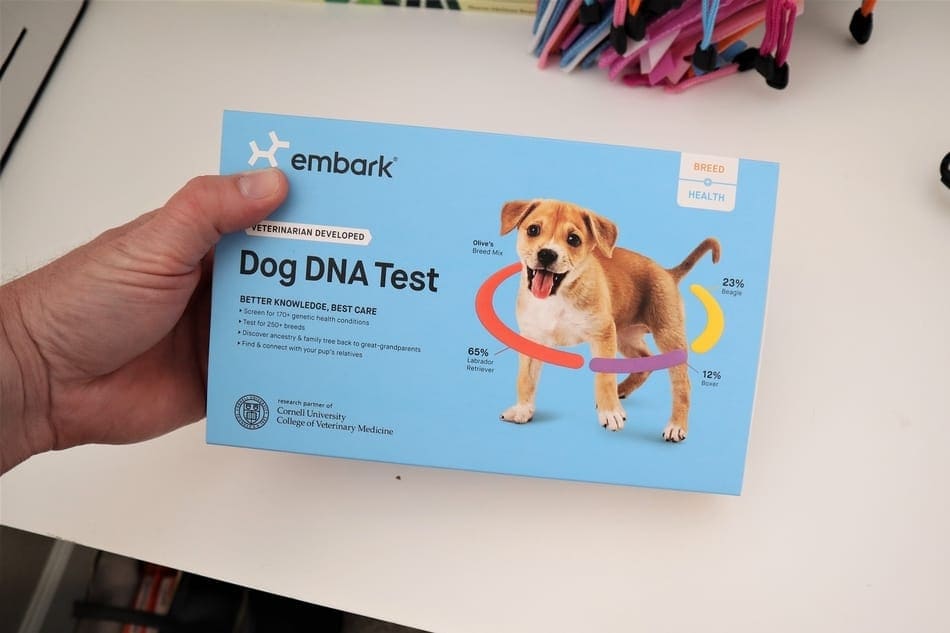
The main features of this specific kit which finally convinced me to make them my go-to provider for home Doberman DNA testing are:
- 215+ health conditions are tested for which (more importantly) includes all the serious health conditions afflicting the Doberman breed.
- They’re the most accurate dog DNA test kit on the market and analyze over 200,000 genetic markers.
- Coefficient of inbreeding (COI) results are included.
- It includes the world’s only dog relative finder—find genetic matches to your dog and message the owners (possible siblings, parents, offspring, etc)!
- Breed identification going back 3 generations in your dog’s family tree is included. This will identify any influences in your dog’s DNA makeup that may not be of Doberman origin. Even if these are incredibly small. This will tell you if your dog is truly 100% Doberman.
- Embark has a larger database of DNA records than the other test providers (over 350 breed DNA profiles are included in their database). This helps to make identifying your dog’s exact genetic influences and breed history far more accurate. They cover 98% of dogs in America.
- Other factors are checked that are of interest to Doberman owners including color genetics, albinoid testing, genetic sensitivities to medications, and a long list of physical characteristics of your dog when he or she is full-grown (it’ll give you an idea of their final size, weight, muscle mass, etc).
- Results are equally useful to both American and European Doberman owners.
- A simple at-home cheek swab method of collecting DNA.
- Relatively fast turnaround times (generally get results in 1-3 weeks).
- A collaborative relationship between Embark and the Doberman Diversity Project exists which makes it simple to donate results to this non-profit. Donating your results will help with their work to improve the health of future generations of Dobermans.
These are the main reasons why I settled on this specific kit from Embark as the best on the market for Doberman owners to utilize for getting a glimpse into the inner workings, and potential future health conditions, of their dogs.
This kit has become increasingly popular with Doberman breeders recently and very often breeders are now using this specific kit to check the DNA of their entire litters. The comprehensiveness of the results makes it easy for breeders to reassure potential buyers.
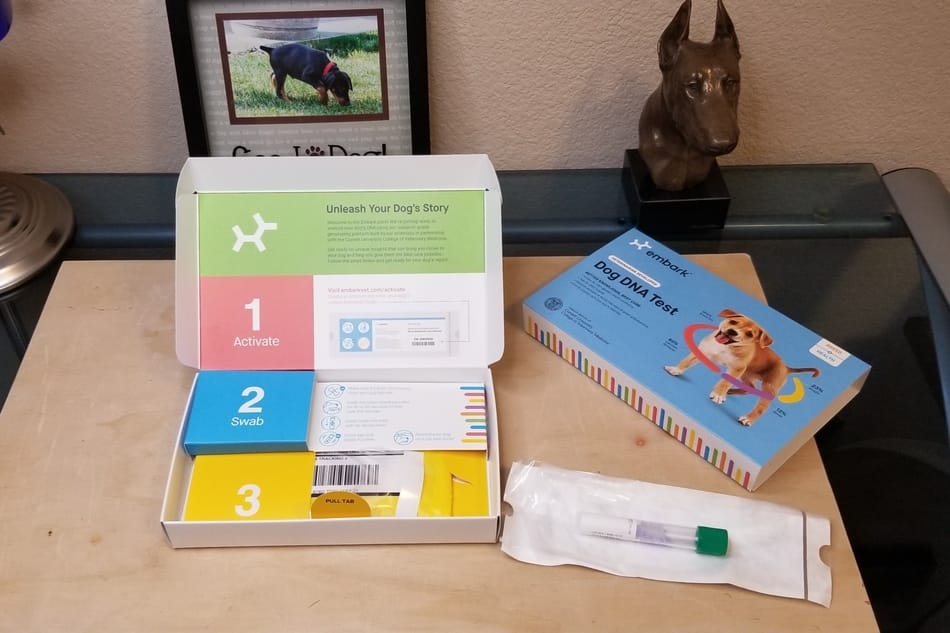
How to Health Test Your Doberman
For the sake of this guide, I will be basing my instructions on the specific Embark kit that I used on my Doberman puppy (linked to in the previous section). Be aware that these instructions likely will not apply to other kits.
Once you’ve ordered the specific Embark kit recommended in the link above, now it’s time to test your dog. In order to provide you with the most specific and accurate instructions, I ordered the same kit and tested my newest addition to my family, Arlo. He is a European Doberman puppy who (at the time of testing) is about 16 weeks old. This kit will work on Dobermans of all ages however the Doberman Diversity Project recommends testing a puppy at 3 weeks of age or older to help avoid cross-contamination.
If you’ve ordered the correct kit, you will see it broken down into three sections when you open the box: the “1 – Activate”, “2 – Swab”, and “3 – Send”.
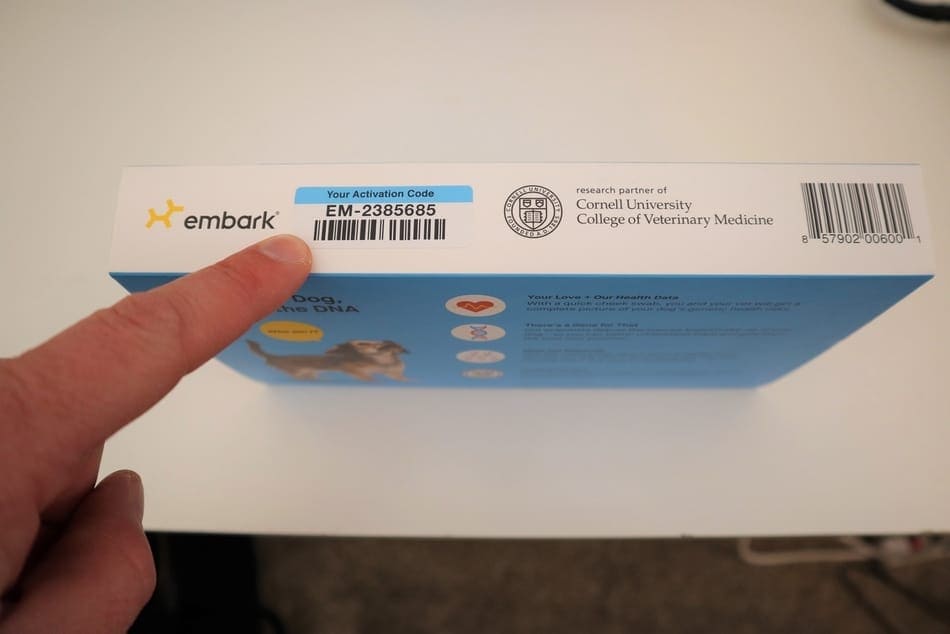
Step 1: Get the Right DNA Test Kit
After significant research, it’s clear to me that this DNA testing kit from Embark is the best kit for the Doberman breed and provides, by far, the most complete insight into this breed. Embark has collaborations with the Doberman Diversity Project, Cornell University College of Veterinary Medicine, and so many others.
Get the Test Kit:
Use a Coupon Code:
- DOBERMANPLANET – $5 off Breed + Health Kit (STACKABLE with any other current promotions!)
- MULTIPACK2 – 10% off 2 Breed + Health kits
- MULTIPACK3 – 15% off 3 Breed + Health kits
- MULTIPACK4 – 20% off 4 or more Breed + Health kits
Once you order your kit you should receive it in just a few days. Mine took two business days to show up at my front door.

Step 2: Activate Your Kit
You should see a small barcode printed on both the outside of your kit’s box and on the packaging for the swab inside the box (in section two—the blue section). The barcode will look something like this: EM-1234567. This is the code you’ll need to activate your kit.
Next, go to embarkvet.com/activate. This will bring you to a login page. At the bottom of the login section, click “sign up” to create an account with Embark. Fill out the requested information and click “sign up.”
Now you’ll have to create a profile for your dog on their site, but this is pretty simple. Just enter your dog’s name and answer the remaining questions on that page. When you’re done click “Continue” at the bottom of the page. A summary of what you entered should appear, if you want to add another dog to your profile for testing, just click “No, let’s add another dog”. Otherwise, just click the “Yes, we’re done” button if everything looks good.
The next screen will ask you which dog you’d like to activate your kit for. Select your dog and click “Continue.” Then you’ll enter the number from the barcode printed on your box (and on the cheek swab packaging inside your kit). Then it’ll ask you a few more questions about how you would like to get notified when the results are ready and finally send you to a summary of what you entered about your dog.
If you see the words “Activated. Swab activated on (date), awaiting return” on your main account screen then everything is set! If you’re testing multiple dogs, it’s a good idea to use a sharpie and write the dog’s name on the cheek swab packaging so you don’t get the swabs confused while using multiple test kits.
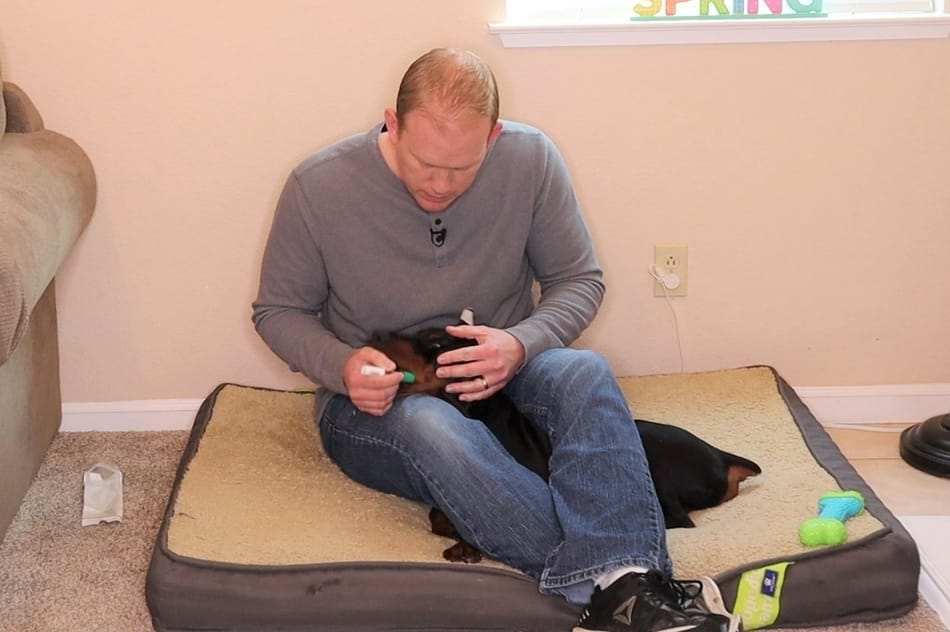
Step 3: Swab Your Dog
Now it’s time to swab your dog’s cheek and collect a sample of their DNA. The swab is pretty easy to use. Start by removing the swab from the plastic packaging, and place the end of the swab (the spongy, q-tip looking end) into one of the lower pouches of your dog’s cheek.
These pouches are located between the gums of their most rearward molars and their cheek. If you feel down towards the bottom jaw area here, you’ll notice a pouch-like area where the drool tends to pool up. This is the area you want to use to soak the swab end in.
Place the swab in this pouch and move it around subtly while slowly spinning it to thoroughly soak it. Do this for about 30 to 60 seconds to make sure the whole sponge is soaked in your dog’s saliva.
Here are some important points about doing this:
- Only swab your dog’s cheek at a time when your dog hasn’t had anything to eat for at least 30 minutes prior or had anything to drink for at least 10 minutes prior (although longer is better).
- Don’t let your dog chew on the swab while collecting your sample.
- Either side of the cheek is fine to use.
Once you’ve soaked the end of the swab’s sponge in your dog’s saliva, unscrew the plastic cap that is connected to the base of the sponge, turn the swab upside down, place it into the handle (or tube), and screw it on firmly. You’ll be placing the swab’s sponge end into the liquid that you saw inside the handle of the swab.
Once the lid is tight, shake the vile at least 10 times. This will cause the liquid inside the vile to finish soaking into the spongy part of the swab and will help stabilize the DNA for transport.
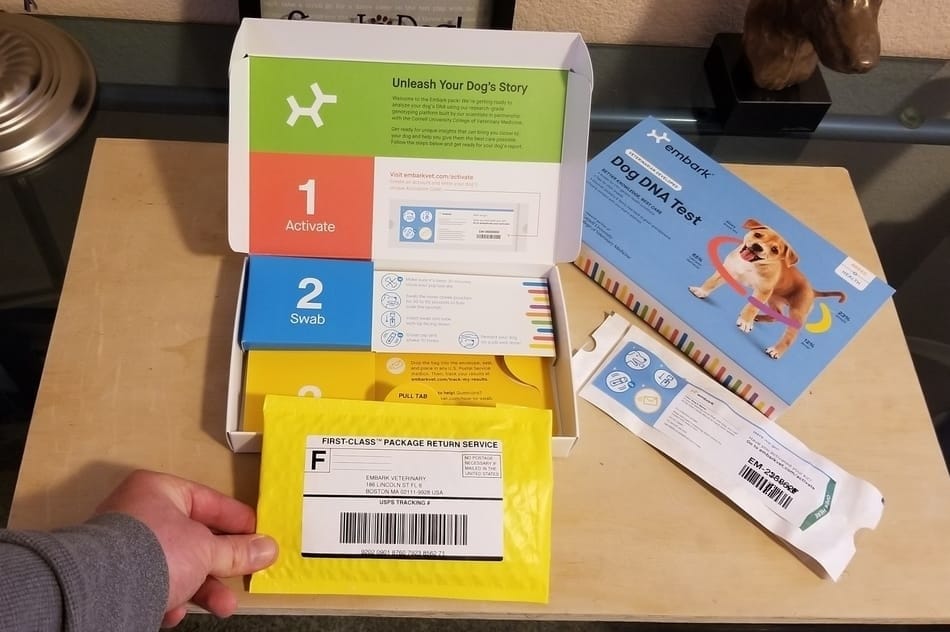
Step 4: Send the Swab Back
Once your swab is sealed inside the vile, place it inside the clear plastic bag that is inside your kit (in the yellow section of the box), and seal it. Then place that bag into the included padded envelope and seal the envelope.
The postage on this envelope is prepaid so all you need to do is put it in your mailbox or drop it off in any U.S. Postal Service mailbox.
Now just wait for the e-mail or text for notification that your dog’s DNA results are ready!
Step 5: Review Results
You’ll receive an e-mail with the subject line “Health and Breed Results are ready!” when your results are ready to be viewed. When you get this message, just click on the link in the e-mail which will take you back to Embark’s login page.
Once you log in with the e-mail address and password you created when activating the kit, you’ll be able to see your dog’s test results! Along the top of the screen, you should see the options of research, health, breed, traits, and relatives.
The research section appeared there when you first activated your account but the health breed, traits, and relatives options will only appear once your results are ready.
- Health Tab – Under the health tab you’ll see your dog’s health results, the coefficient of inbreeding (COI), and other health-relevant results.
- Breed Tab – Under the breed tab you’ll see your dog’s breed result, family tree, the maternal haplotype, and paternal haplotype. The breed result will tell you what percentage of Doberman your dog is. The family tree will show you visually all the breed influences in your dog going back three generations. This means it’ll show you the breeds of the past 14 ancestors in your dog’s genetic makeup. If your dog is 100% Doberman Pinscher, then all 14 dogs in this tree will be Dobermans. The “haplotype” sections will give you a visual representation of where in the world your dog’s ancient ancestors came from—pretty cool!
- Traits Tab – This will give you information on the physical traits of your dog that were apparent from their DNA. Such as their fur color, coat traits, muzzle length, tail length, hind dewclaws, muscle and bulk, eye color, high altitude tolerance, and appetite. Much of this you probably already know about your dog but it’s really interesting to see what color puppies your dog can make. Can they make diluted color Dobermans like the fawn and blue Dobermans? How about white Dobermans (“Z-factor” dogs)? This is where it will tell you.
- Relatives Tab – Other dogs that Embark has tested which are closely related to your dog will appear here. You’ll see a list of dogs whose DNA closely matches your dog’s DNA. These dogs might be siblings, parents, or in the case of my dog Arlo, I found a close relative who shares the same grandfather as my dog. It’ll also allow you to message the owners and chat about your dogs, where you got them from, set up play-dates, etc.
Use the “Interpreting the Results” section of this article to help guide you through which specific results you should pay close attention to as a Doberman owner, and what they mean in simplified terms.
Step 6: Donate the Results to Research
The Doberman Diversity Project (DDP) is a true blessing to the Doberman breed, and frankly, in my opinion, might ultimately prove to be this breed’s saving grace for future generations. The DDP is a non-profit organization that’s dedicated to reducing the occurrence of heritable diseases in the Doberman breed and addressing the issues that are leading to a lack of genetic diversity in the breed.
Luckily, Embark and the Doberman Diversity Project work together to help further this goal. The DDP has a very simple way that everyday owners of Dobermans (like you and I) can donate our dog’s DNA results to their organization. This is free, quick, and easy to do and allows the DDP to use your dog’s DNA profile in their research. This certainly has the potential to greatly impact the Doberman breed in a very positive way.
So it really is critical that you donate your dog’s results to this organization for their research. To do this, simply do the following.
- Go to the Embark login page here and log in to your Embark account.
- Under your dog’s profile page, look for the section titled “Print or Download Results” and click on “Raw Data.”
- On the page that comes up, click on the two buttons to download the ZIP and the CSV files to your computer. This is your dog’s DNA profile you’re downloading!
- Go to the Doberman Diversity Project’s Submit Embark Results page here.
- Fill out your dog’s basic information on that page and upload both your ZIP and CSV files to the same page (click the “choose file” button on the page for each of these).
- Briefly describe your Doberman’s current health status in the comments section of that form (e.g. “Diagnosed with DCM via Holter and Echocardiogram”).
- Click “Submit”.
For a step-by-step walkthrough of how to do this, see my YouTube video about donating your Doberman’s DNA results here. You can skip to 8:11 into the video if you just want to see the instructions for donating your results to the DDP.
That’s it, once you’ve done that, by taking that simple action you’ve done more than most owners do to ensure a brighter future for Dobermans!
But your job shouldn’t stop there. You should also return to the DDP and update them on any changes in your dog’s health. This is where you can go from a hero who has donated genetic results for research, to a superstar who just made their dog’s genetic information many magnitudes more valuable to this organization’s important research.
Make sure you go to the Doberman Diversity Project’s Update Portal here and update them when (or if) any of the following occur:
- Your dog is diagnosed with DCM.
- Your dog passes away.
- You perform a holter or echo on your dog.
- Your dog is 10 years of age or older.
- Any other changes in your Doberman’s health.
Getting your dog tested is great, donating the results is amazing, and updating the DDP with changes in your dog’s health after donating the results is probably the single, most important, thing you can do to help researchers ultimate reduce or eliminate the occurrence of many of the serious conditions that plague the Doberman breed today.
If you’d like to make a monetary donation to the Doberman Diversity Project, you can do so by going to their donation page here. Not only will your donation go far in helping improve the future of our favorite breed, but it can also help with your taxes at the end of the year!
Interpreting the Results
The combination of results you might receive for your Doberman is endless. However, I’ll go over some of the most common results for the Doberman breed that you should pay attention to and what they mean.

Dilated Cardiomyopathy, DCM1
The results for the DCM1 test are found under the “Health” tab in your account. Once there, click on “Breed-Relevant Conditions” to see this result. This test looks for how many copies of the mutated PDK4 gene have been detected.
Possible Results
| Mutations Present | What it Means |
|---|---|
| 0 Copies |
This is considered a “clear” or “normal” result. It means that the mutation in the PDK4 gene that has been linked to the development of dilated cardiomyopathy in Dobermans was not detected. In other words, your dog has zero copies of this mutation. This is widely considered to be the most desirable result by Doberman owners. However, you should note that it’s still possible for your dog to develop DCM even with this result. |
| 1 Copy | This is called a “positive heterozygous” result. This means the test detected only one copy of the mutated PDK4 gene. PDK4 is considered a “dominant mutation with incomplete penetrance”. Basically this means that one copy of this gene mutation infers the same risk of developing DCM as having two copies of PDK4 mutation. This may mean that your dog is at an increased risk of developing DCM during their lifetime. This mutation will be passed onto about 50% of your dog’s offspring. |
| 2 Copies | This is called a “positive homozygous” result. This means the test detected two copies of the mutated PDK4 gene. PDK4 is considered a “dominant mutation with incomplete penetrance”. This means that a dog with two copies of this mutation has the same increased risk of developing DCM as a dog with one copy. Most Doberman owners consider this to be the least desirable result. This result may mean that your dog is at an increased risk of developing DCM during their lifetime and your dog will pass this mutation on to 100% of their offspring. |
In one study published by North Carolina State University College of Veterinary Medicine, 132 Doberman Pinschers were evaluated and of those, 66 had the PDK4 gene mutation and 66 did not. In that study, 82% of the Dobermans with the PDK4 gene mutation were affected by DCM. Whereas only 39% of the Dobermans without the PDK4 gene mutations were affected by DCM (source).
A later study published by the Institute of Genetics, University of Bern in Switzerland concluded that PDK4 mutation present in European Dobermans did not produce an increased risk of developing DCM (source).
However, if you have a European Doberman, don’t let this give you a false sense that your dog is somehow immune to DCM because that is certainly not the case. In fact, DCM prevalence in European Dobermans is quite high and affects as much as 58.2% of the population according to a study published by Ludwig Maximilians University in Munich, Germany (source). So DCM is still occurring quite frequently in European Dobermans, but it seems that the DCM1 test isn’t likely to be any kind of predictor of this in the European dogs.
To learn more about DCM within the Doberman breed, see my article Doberman Pinscher Dilated Cardiomyopathy (DCM) Simplified.

Dilated Cardiomyopathy, DCM2
The DCM2 test result can be found under the “Health” tab in your account. Once there, click on “Breed-Relevant Conditions”. This test looks for a mutation affecting the TTN gene.
Possible Results
| Mutations Present | What it Means |
|---|---|
| 0 Copies |
This is considered a “clear” or “normal” result. This result means the test did not detect any mutations in the TTN gene that have been linked to the development of DCM in Dobermans. This is widely considered to be the most desirable result by Doberman owners. Keep in mind that a dog who has this result can still develop DCM, although they are at a lower risk of it. |
| 1 Copy | This is also called a “positive heterozygous” result and it means that the test detected one copy of the mutated TTN gene. DCM2 is considered a “dominant mutation with incomplete penetrance”. This means that having one copy of the TTN mutation carries the same risk of developing DCM as having two copies. However, on average your dog will pass the mutation on to only 50% of their offspring. |
| 2 Copies | This is also called a “positive homozygous” result, it means the test detected two copies of the mutated TTN gene. This is widely considered to be the least desirable result by Doberman owners. DCM2 is considered a “dominant mutation with incomplete penetrance”. This means that having two copies of the TTN mutation carries the same increased risk of developing DCM as having one copy, however, your dog will pass the mutation on to 100% of their offspring. |
I’m not aware of any studies involving the DCM2 test that relate specifically to European Dobermans at the moment, its effects on European Dobermans are unknown. The majority of studies involving the TTN gene mutations in Dobermans have revolved around assessing American Doberman Pinschers such as this study by Kathryn M. Meurs of North Carolina State Veterinary Medicine.
To learn more about DCM within the Doberman breed, see my article Doberman Pinscher Dilated Cardiomyopathy (DCM) Simplified.
Von Willebrand Disease Type I
The Von Willebrand Disease Type I test result is found by going to the “Health” tab in your account and clicking on “Breed-Relevant Conditions”. This test looks for a mutation affecting the VWF gene.
Possible Results
| Mutations Present | What it Means |
|---|---|
| 0 Copies |
This is considered a “clear” or “normal” result. This result means the test did not detect any copies of the mutated VWF gene. This is the best possible result and means your dog is unaffected. Your dog is among the groups least likely to develop vWD. The dog will not pass on this condition to its offspring. |
| 1 Copy | This is considered a “low-risk” or “carrier” result. It’s also called a “positive heterozygous” result. It means the test detected one copy of the mutated gene. The dog might be affected and may develop vWD. Your dog is also able to pass the mutation on to its offspring. |
| 2 Copies | This is considered an “increased risk” or “affected” result. This is also called a “positive homozygous” result and indicates that the test detected two copies of the mutated gene. This is widely considered the least desirable result by Doberman owners and indicates that the dog may be affected and has a high risk of developing this vWD. This also means the dog will certainly pass the mutated gene on to its offspring. Note that not all dogs who have both copies of this gene will develop vWD. |
Luckily, Von Willebrand Disease Type 1 is the least severe of all the vWD types. Most Dobermans who have this disorder do not die from it as it’s usually well managed with proper medical care. Even if your dog tests to have two copies of the mutated gene, it still doesn’t mean that they will develop the disorder, only that they are at an increased risk.
Deafness and Vestibular Syndrome, DVDob, DINGS
The DINGS test result is under the “Health” tab in your account. Once there, click on “Breed-Relevant Conditions”. This test looks for a mutation affecting the MYO7A gene.
Possible Results
| Mutations Present | What it Means |
|---|---|
| 0 Copies |
This is considered a “clear” or “normal” result. It means that your dog is clear of the mutation in the MYO7A gene that has been linked to this condition. The dog is unaffected and will not pass this on to its offspring. This is the most desirable result. |
| 1 Copy | This is considered a “low-risk” or “carrier” result. It’s also called a “positive heterozygous” result and indicates that one copy of the mutated gene was detected. The dog may pass the mutation on to its offspring. |
| 2 Copies | This is considered an “increased risk” or “affected” result. It’s also called a “positive homozygous” result and indicates that two copies of the mutated gene were detected. The dog will pass the mutation on to its offspring. |
Current research seems to suggest that this disorder is an autosomal recessive disease, which means that two copies of the mutated gene are required for it to develop. If this is true, it means that if testing shows that only one copy of the gene is present, then the dog won’t be affected but could pass the gene on to its offspring.

ALT Activity
The ALT activity test result can be found under the “Health” tab and then “Clinician Tools” in your Embark account. This test checks for a mutation involving the GPT gene.
Possible Results
| Mutations Present | What it Means |
|---|---|
| 0 Copies |
This is considered a “clear” or “normal” result. It means that your dog is clear of this mutation and should be treated normally by their veterinarian when measuring liver health using ALT enzyme levels. |
| 1 Copy | This is considered a “low-risk” or “carrier” result. It’s also called a “positive heterozygous” result. This indicates that the dog’s natural ALT enzyme levels will be on the low end which could make it difficult for your veterinarian to accurately measure the liver health of your dog. If your dog receives this result, your veterinarian may want to do blood work to establish a baseline of their normal ALT levels to better judge how their liver health changes later on in life. This condition may be passed down to your dog’s offspring. |
| 2 Copies | This is considered an “increased risk” or “affected” result. It’s also called a “positive homozygous” result. This has a similar implication as to the previous result. This result indicated that your dog’s ALT enzymes may be naturally lower than other dogs. This can make accurately gauging the future health of your dog’s liver difficult for your veterinarian. Your veterinarian will likely want to do blood work on your dog if you receive this result to establish a baseline (or reference point) for judging future changes in your dog’s liver health. This mutation will be passed down to your dog’s offspring. |
The biggest impact of this condition is simply that it skews what the “normal range” should be for your dog’s ALT liver enzymes. If your Doberman has this condition and your veterinarian is not aware, then it’ll make reading their bloodwork problematic.
For example, your vet may think that your dog’s liver is healthy from the results of the blood work since it shows their ALT enzymes levels are within the normal range, but if your dog is affected by this condition, their “normal range” might be quite a bit lower than expected. It’s good to make your veterinarian aware of this condition if your dog is affected by it so they will be able to spot problems in your dog’s liver function in the future.

Coefficient of Inbreeding (COI)
Your Doberman’s coefficient of inbreeding percentage can be found under the “Health” tab and “Inbreeding and Diversity”. This test measures how closely your dog’s parents were related genetically. It can gauge the overall diversity (or lack of) in your Doberman’s genetics. This is an absolutely amazing and fascinating test that can give you a ton of insight into your dog’s health.
Inbreeding has been proven to reduce the vitality and the lifespan of a dog by 6 to 10 months for every 10% increase in inbreeding in the dog’s genetic makeup.
Unfortunately, the Doberman Pinscher’s levels of inbreeding are normally quite a bit higher than many other breeds. As you can see from the curve below, the yellow dotted line gives you an idea of how inbred other Dobermans typically are and the grey line shows you how inbred the typical purebred dog is, of all breeds.

The small arrow shows the result I got while testing my new Doberman puppy, Arlo. His coefficient of inbreeding is 48% which puts him a bit higher than the average Doberman in terms of inbreeding.
If I were to assume the average lifespan of a Doberman is 10-13 years and the average COI of the Doberman, based on this chart’s data, is somewhere in the ballpark of 35%, I might conclude that the predicted lifespan of my dog might just be on the lower end of that range. However, there is some recent concerning research that indicates that the average lifespan of a Doberman may be closer to 8 years. If that were the case, certainly these numbers would look significantly more grim.
There are many problems with making those assumptions however since the COI does not directly translate to lifespan in that way. However, it has been shown to have a link to the projected lifespan of a dog and so that’s what makes these numbers so fascinating to me and makes it so difficult for me to avoid drawing those conclusions—as problematic as they might be.
Please keep in mind though that the COI is not meant to be an accurate predictor of how long a dog will live, only their genetic diversity. If you want to learn more about the COI and what it means, take a look at COI FAQS: Understanding the Coefficient of Inbreeding by Carol Beuchat Ph.D.
Get the same kit I used on my dog Arlo, which will give you the Coefficient of Inbreeding (COI) number for your dog here.
B (Brown) Locus
This result can be found by going to the “Traits” tab and then looking under the section titled “Base Coat Color.” This result will give you an idea of pigment colors your dog is able to produce in its offspring. “B” is the dominant black color-producing gene and “b” is the recessive red color-producing gene.
Possible Results
- BB – This result means your dog is black in color and cannot produce red offspring.
- Bb – This result means your dog is black in color but can produce red offspring.
- bb – This result means your dog is red in color and can produce red offspring.
Since the red producing gene (b) is recessive, dogs who have the dominant BB will never be able to produce a red puppy no matter who they are bred with. However, if your dog has at least one copy of the recessive red gene (b) and is bred with another Doberman who also has at least one recessive red gene, red pups can be born.
This information combined with the information in the following section (the D locus result) will tell you all the various color combinations your dog can produce in its offspring. The D locus is a dilution factor gene so it can change the appearance of the red and black Dobermans and that is why it must also be considered when attempting to figure out all the various colors your dog can produce in their puppies.
D (Dilute) Locus
This result can also be found in the “Traits” tab. Once there, look for “Base Coat Color” and you will see this result. This gene is also known as the “color dilution gene” and is responsible for diluting (or not diluting) the color that is produced in the dog by the B locus in the previous section.
A “diluted” color Doberman means either a fawn (Isabella) or blue Doberman.
Possible Results
- DD – This result means your dog is not a diluted color themselves and does not carry the gene necessary to make diluted colored Dobermans (blues and fawns).
- Dd – This result means that your dog is not a diluted color themselves but does carry the gene necessary to make diluted colored Dobermans (blues and fawns).
- dd – This result means that your dog is a diluted color themselves (either blue or fawn depending on the B locus results in the previous section) and can make other diluted colored Dobermans (blues and fawns).
If a diluted color is produced, the dog will make either fawn or blue-colored offspring. A fawn-colored Doberman is simply a dog whose B locus set the dog up to be a red-colored dog but the D locus diluted the red coloring, which appears to be a fawn-type color.
A blue-colored Doberman is simply a dog whose B locus set the dog up to be a standard black-colored dog but the D locus diluted the black coloring, which made the dog appear a blueish or silver color.
To learn more about all the various colors that are possible with Dobermans, see my article All the Colors and Types of the Doberman.

Oculocutaneous Albinism Type 2 (OCA2)
You can find this result if you do under the “Traits” tab of your Embark account and scroll down to the “Other Coat Traits” section. This test will indicate if you have a Doberman who has a partial deletion of the SLC45A2 gene which is known to create tyrosinase-positive oculocutaneous albinism (OCA2). This is what creates what’s known as a “Z-factor Doberman” which is also often called a white, cream, or albino Doberman.
Possible Results
- NN – This result indicates that your dog is not affected by this mutation and cannot pass it on to their offspring. They are unable to produce white Dobermans.
- ND – This result indicates that your dog is not affected by this mutation (meaning they are not a white Doberman themselves) but they carry the gene mutation for it and can pass it on to their offspring. If your dog mates with another ND dog or DD dog, they can produce white Doberman puppies.
- DD – This result indicates that your dog is affected by this mutation and has OCA2. Your dog will appear white or cream in color and can produce white-colored puppies if bred with an ND or DD Doberman. This trait can also be passed on to their offspring.
All known white Dobermans are thought to have descended from a Doberman named Padula’s Queen Sheba (aka “Sheba”), a white Doberman born in 1976. If you would like to learn more about the white Doberman including why they exist and the controversy surrounding them, see my article The White Doberman Pinscher: Pictures, Cost, Health, and More.
Decoding Your Dog’s Color Genetics
Once you have both B locus and D locus results, you can combine them to tell you exactly what colored puppies your dog is able to create. Here are some example results below made by combining these two results.
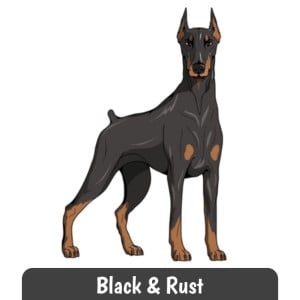
A black dog can be any of the following:
- BBDD – This is a black Doberman that can produce black, but not red colored offspring and cannot produce diluted colored (blue and fawn) offspring. This dog is only capable of producing black Dobermans.
- BBDd – This is a black Doberman that can produce black, but not red colored offspring but can produce diluted (blue and fawn) colored offspring depending on their mate.
- BbDD – This is a black Doberman that can produce black or red offspring depending on their mate, but not diluted colored (blue and fawn) offspring.
- BbDd – This is a black Doberman that can produce black, red, and diluted colored (blue and fawn) offspring depending on their mate.
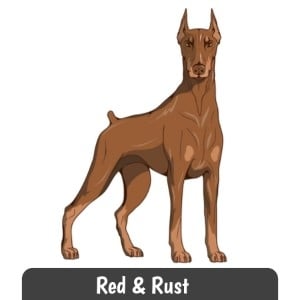
A red dog can be any of the following:
- bbDD – This is a red Doberman that can produce black or red but cannot produce diluted colored (blue and fawn) offspring depending on their mate.
- bbDd – This is a red Doberman that can produce black, red, and both diluted colored (blue and fawn) offspring depending on their mate.
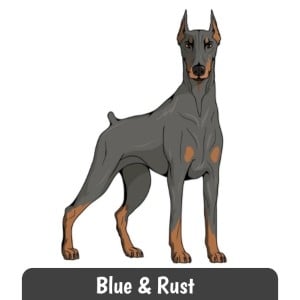
A blue dog can be any of the following:
- BBdd – This is a blue Doberman that cannot produce red but can produce blue offspring depending on their mate.
- Bbdd – This is a blue Doberman that can produce black, red, and both diluted colored (blue and fawn) offspring depending on their mate.
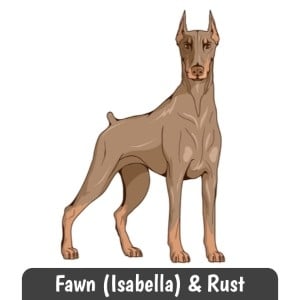
A fawn dog can be any of the following:
- bbdd – This is a fawn (or Isabella) colored Doberman that can produce black, red, and both diluted colored (blue and fawn) offspring depending on their mate.
Since the gene that creates the red Dobermans (located on the B locus) is recessive, you need to have both recessive versions of the gene (b) in order for the dog to come out as a red color. For a dog to come out as black, they only need one version of the dominant black-colored gene (B).
Regardless of what the B and D locus results are, if your dog is affected by Oculocutaneous Albinism Type 2 (OCA2), this will mask the color of the dog and they will appear white or cream in color.
For more information on the various color combinations of Doberman puppies that can be produced by your dog once you have these results, take a look at the DPCA’s Color Inheritance Chart.
Breeding Implications
For most of the gene’s affecting the Doberman breed, it’s usually considered safe to breed a carrier of that specific mutation with a mate that is clear. This will produce puppies that are either clear of the mutation or a carrier, but it is not possible to produce puppies who are affected by the condition.
Most breeding programs agree that it’s simply not possible to limit the breeding of only Doberman mates who are both clear of every genetic condition as this will severely limit the gene pool and likely have other negative health consequences, such as raising the breed’s overall coefficient of inbreeding (COI).

Final Thoughts
This means that it’s incredibly important that every owner of a Doberman does DNA-based health testing at some point in their dog’s life. I performed this DNA testing on my most recent Doberman puppy at about 4 months of age, but it can be performed at any point in the Doberman’s life.
Testing your dog will give you an idea of health conditions your specific dog is likely to develop over their lifetime, a glimpse into their potential lifespan, and insight into what genetic traits they may pass on to their offspring if you plan to breed.
Having this clear picture of your Doberman’s DNA makeup can help your veterinarian take the necessary steps to lessen the impact of certain disorders your dog may face later in life. This is an amazing tool that provides an impressive level of insight into your dog’s inner workings that we simply haven’t had in generations past.
Also, by donating the genetic results you receive from Embark to programs such as the Doberman Diversity Project, you can have a significant impact on the betterment of the Doberman breed in future generations—something all Doberman owners, including myself, will be grateful for.
The Doberman breed might be affected by a large number of issues as purebreds go, but we don’t need to go into this blind. I urge you to test your dog as I did with Arlo, so you know what you’re up against and to contribute your dog’s genetic results to research to help better future generations of the Doberman breed.
If you see Arlo’s picture in your dog’s matched relatives after testing, send me a message and say hi, our dog’s might just be related!
Neither this site, its owners, or this guide are associated with or endorsed by Embark. You can read our complete terms and conditions for more details.


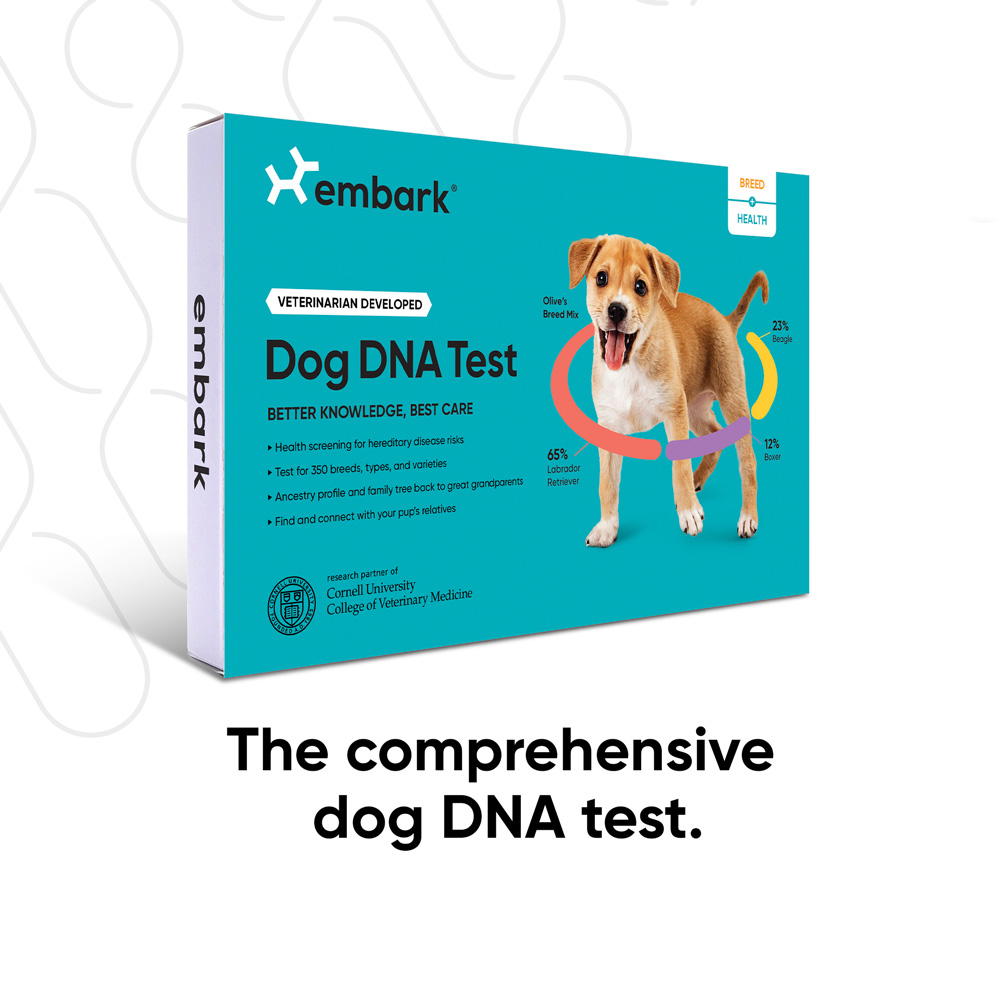


Thanks for this recommendation. I got my test kit’s in the mail today (I ordered 2 for both my girls). They came in an envelope, not a box. My question though is that they sent 4 test kits. Am I suppose to swab both cheeks? Or did they mess up and send me extra?
I’d give them a ring and ask what happened. But no, you only need one physical swab per dog and only need to swab one cheek per dog.
When I purchased my first Doberman from a responsible show breeder in 1981, I felt that no one knew less about dogs, and Dobermans in particular, than I. I gained an outstanding education from the start, from her breeders, dog trainers, the area Doberman Pinscher Club and more. Within several months, I realized not all puppy buyers I met had received education and mentoring, and that kindled my interest in helping Dobermans and their owners. I founded Doberman Pinscher Rescue of PA, Inc. in 1989. Trish Gilberti Labelle shared your comprehensive overview of the Doberman with our board, and I compliment you on your achievement! Your writing, organization, advice and recommendations reflect great clarity and insight, and I wanted to congratulate and thank you for this much-needed work!
Thank you so much Pam, I can’t tell you how much that means to me. Please keep up the good work your organization is doing for the Doberman breed, it really does make a positive impact on the breed we are all so in love with.